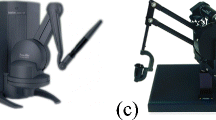Abstract
At present, several commercially available surgical simulators have been used in advanced medical facilities, and most of them provide a self-learning environment for trainees who are young doctors and/or residents. Therefore, we assume that inexperienced doctors have to inherit the veteran skills of experienced doctors because the lack of doctors and nurses is one of the most serious medical issues. This article proposes a training function on a surgical simulator system which enables trainees to sense the feelings of experienced surgeons while operating. The inheritance assistance function we are constructing might be of help in compensating for the lack of experience of young doctors and be more effective than the present system. The inheritance assistance function makes it possible to record the operational data of experienced doctors, and to reproduce this data in a training scene for young trainees. Then young doctors could practice their own skills by intuitively referencing the recorded advisory data in a surgical simulator. In order to accomplish the purpose of this study, we have constructed a fundamental system. A simple virtual object based on a dynamic model reacts in terms of visualization and force against the manipulation of virtual forceps via a haptic device, PHANToM. Several laboratory students of the experimental subject were challenged to obtain training with the system developed. This article describes the system and discusses the results and future work.
Similar content being viewed by others
References
Webster RW, et al (2001) A prototype haptic suturing simulator: medicine meets virtual reality. pp 567–569
Bro-Nielsen M, et al (1998) VR simulation of abdominal trauma surgery. Stud Health Technol Inform 50:117–123
Woodrum DT, et al (2006) Construct validity of the LapSim laparoscopic surgical simulator. Am J Surg 191:28–32
Yamauchi Y (2006) Is force-feedback effective on surgical assist devices? Perception of elasticity through forceps. J Jpn Soc Comput Aided Surg 8(3):270–271
Tokuyasu T, et al (2005) Development of a simulation system with a haptic device for cardiac muscle palpation. Comput Assist Radiol Surg 1:539
Author information
Authors and Affiliations
Corresponding author
Additional information
This work was presented in part at the 15th International Symposium on Artifi cial Life and Robotics, Oita, Japan, February 4–6, 2010
About this article
Cite this article
Tokuyasu, T., Yufu, K., Shuto, T. et al. Development of an inheritance assist system for experiencing operation skills by using a haptic function of PHANToM. Artif Life Robotics 15, 195–198 (2010). https://doi.org/10.1007/s10015-010-0789-4
Received:
Accepted:
Published:
Issue Date:
DOI: https://doi.org/10.1007/s10015-010-0789-4




